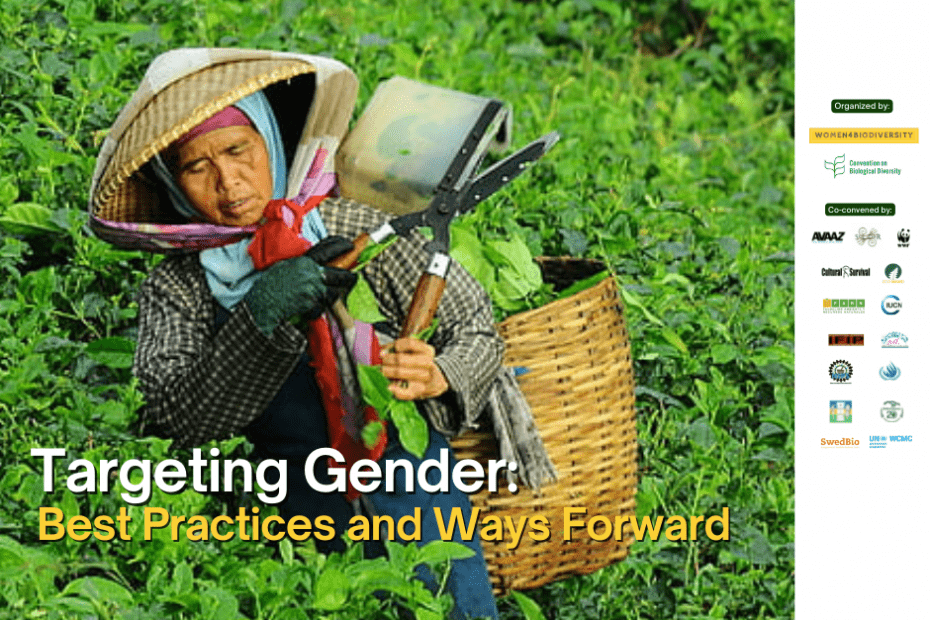Watch the event replay here.
The first day of the Convention on Biological Diversity (CBD) meetings in Geneva witnessed not only the opening statements of Parties and observers but also the side event “Targeting Gender: Best Practices and Ways Forward.” It provided a platform to advance gender considerations in the post-2020 global biodiversity framework and its implementation by sharing reflections on the framework and the draft post-2020 Gender Plan of Action.
The event was co-hosted by Women4Biodiversity and the CBD Secretariat, and co-convened by International Union for Conservation of Nature (IUCN), Office of the High Commissioner for Human Rights (OHCHR), SwedBio, UN Environment Programme World Conservation Monitoring Centre (UNEP-WCMC), WWF International, and with the Women’s Caucus- UNCBD Members CoopeSolidar-Costa Rica, Fundación Ambiente y Recursos Naturales (FARN) Argentina, Indigenous Women’s Network in Thailand (IWNT), Network of Indigenous Peoples in Solomon (NIPS), Pastoral Communities Empowerment Programme (PACEP), International Funders for Indigenous Peoples (IFIP), Avaaz, Cultural Survival, Eco Maxei Querétaro AC and Reforestamos México AC.
Women as agents and leaders of change
Keynote speaker CBD Executive Secretary Elizabeth Maruma Mrema said that gender is a biodiversity issue and relates the importance of seeing women “not solely as vulnerable actors… but as agents and leaders of change.”
Co-Chairs for the CBD’s Open-Ended Working Group for Post-2020 Global Biodiversity Framework Francis Ogwal and Basil van Havre agreed that gender could be captured more in the post-2020 global biodiversity framework with the support of Parties. Ogwal saw the Gender Plan of Action being discussed concurrently with the post-2020 global biodiversity framework as an opportunity, while van Havre emphasized that the post-2020 global biodiversity framework should be “a framework for all.”
Women’s rights are human rights
Benjamin Schachter, Human Rights Officer of the UN High Commissioner for Human Rights, maintained that “women’s rights are human rights,” including the recently UN-recognized “right to a clean, healthy, and sustainable environment.”
“When we talk about human rights in the context of the post-2020 biodiversity framework, we’re also really talking about gender equality and gender-responsive action as well,” he said.
Schachter cited for further reference an information paper on human rights and gender equality in the environment put together through an expert group meeting convened by UN Women.
A gender-positive 2030
WWF International Global Governance Policy Coordinator Cristina Eghenter says that “to be nature-positive by 2030, we need to be gender-positive.” WWF supports the strengthening of gender equality in the post-2020 global biodiversity framework, including supporting a stand-alone gender target for implementation and accountability. Eghenter also pointed to the need for a strong Gender Plan of Action and indicators.
Opportunities to integrate gender in the post-2020 global biodiversity framework
Katherine Despot-Belmonte, UNEP-WCMC senior programme officer, shared outcomes from an informal dialogue organized by UNEP-WCMC and UN Women to identify opportunities to integrate gender in the post-2020 global biodiversity framework. Parties to the CBD, the CBD Secretariat, and other organizations participated.
Despot-Belmonte said the vision of the dialogue was “equal opportunities for women in participation, equal access to land and resources, and equal benefits from the use of biodiversity.”
The result of the dialogue was a document with recommendations for a gender-responsive post-2020 global biodiversity framework.
Implementation in communities
Indigenous researcher and scientist and member of the International Indigenous Forum on Biodiversity (IIFB) and the Indigenous Women’s Biodiversity Network (IWBN) Guadalupe Yesenia Hernández Márquez underscored the importance of women’s access.
“Access to information and training must reach all communities, even the most remote,” she said.
She added that also important is the commitment of the countries to implement the Gender Plan of Action with measurable goals and “with everything necessary for its implementation: institutional capacity, financial resources and the will of the national governments.”
Best practices in gender and biodiversity for inspiration
During the event, the CBD Secretariat also launched the publication “Best Practices in Gender and Biodiversity: Pathways for multiple benefits,” which showcases ten varied case studies.
CBD Gender Programme Officer Tanya McGregor said that the document shows “the value of women’s collective action, how women’s organizations and networks can help in engaging women…also, spotlighting the importance of equitable access to land and resources.”
“[The publication’s] examples are informative and inspiring, and they offer guidance on how we can reach these shared objectives for gender equality, gender equity and biodiversity in ways that are mutually supporting and contribute to long-term lasting gains,” Mrema said.

